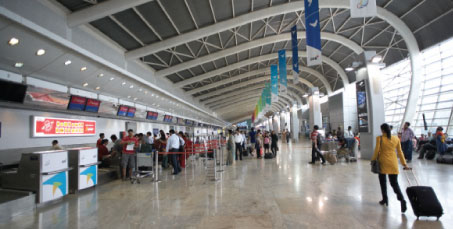
Kalghatgi: “The upgraded runway will also help in increasing CSIA’s runway capacity to handle 40 million passengers in 2013 in a comfortable and well organised manner.”
The works on the main runway and the surrounding airfield entail a complex, three-stage project which initially started in September and is scheduled to be complete in early July 2011.
The first phase of the upgrade to Runway 09/27 involves shortening it by 463 metres at the Runway 27 end and raising it by one metre. This is required to comply with the latest regulations and to match the elevation of the newly constructed Taxiway N.
Alongside this, a number of other vital projects will be carried out, ranging from airside drainage work to the removal of the Runway 09 turn pad, which is no longer required.
While the first phase is ongoing, the second phase is also being undertaken concurrently. Since 1 November, the main runway has been closed between 09:00 and 17:00 hours from Monday to Saturday to allow for resurfacing works to be carried out. This will be ongoing until June 2011 and will also see the runway widened from 45 metres to 60 metres, thereby making it Code-F compliant.
Finally, on 1 February 2011 the third phase will start and this involves the shortening of the Runway 09 end by 258 metres. The parallel drainage along the length of the primary runway will also be replaced and all taxiways connecting to Runway 09/27 will be upgraded, with two new connectivity points added to the network.
“The reconstruction project will help in the upgrade of the main runway and address all compliance issues,” explained Manish Kalghatgi, a member of the Mumbai International Airport Pvt. Ltd (MIAL) management team. “It will further improve the pavement quality of the runway, helping to minimise disruption to aircraft operations and making the surface Code-F compliant. The upgraded runway will also help in increasing CSIA’s runway capacity to handle 40 million passengers in 2013 in a comfortable and well organised manner.”
ASFT’s Weather Report
 ASFT, a family-run developer of surface friction measuring technology, has collaborated with Saab Security to manufacture weather monitoring products. The new range perfectly complements ASFT’s other products, which are approved by FAA, ICAO and UK CAA CAP683 for unrestricted operation at aerodromes. In the partnership, ASFT and Saab Security cooperate in developing and marketing IT systems and products for weather monitoring at airports. ASFT now offers computerised technology for detecting and monitoring freezing points, precipitation, ground frost, ice deposit growth and colour/infra-red camera systems. The technology is purpose-built for stationary or mobile use. With these systems, ASFT offers airports in frosty regions the technology to help save lives and cut costs.
ASFT, a family-run developer of surface friction measuring technology, has collaborated with Saab Security to manufacture weather monitoring products. The new range perfectly complements ASFT’s other products, which are approved by FAA, ICAO and UK CAA CAP683 for unrestricted operation at aerodromes. In the partnership, ASFT and Saab Security cooperate in developing and marketing IT systems and products for weather monitoring at airports. ASFT now offers computerised technology for detecting and monitoring freezing points, precipitation, ground frost, ice deposit growth and colour/infra-red camera systems. The technology is purpose-built for stationary or mobile use. With these systems, ASFT offers airports in frosty regions the technology to help save lives and cut costs.
The product portfolio includes: Frensor – freezing point detection; Optic Eye – precipitation; ground frost measuring; general monitoring computers (GMC); general monitoring systems (GMS); runway weather information systems (RWIS); Advicy – ice warning system; IceMonitor; cameras; and mobile units.
ASFT believes that the new line of products for weather monitoring will prove useful to existing and potential customers around the globe.
Secondary runway
This major reconstruction project follows on from the completion in April of a similar project on the secondary Runway 14/32. As well as the resurfacing of the runway, Central Line and Barrette Approach Lights were also introduced to provide better visibility for landing aircraft, while the runway shoulders on either side were widened to 15 metres to make it compatible for Code-F operations.
Kalghatgi added: “Five new taxiways including two new rapid exit taxiways have also been constructed along the secondary runway to improve the overall efficiency and reduce runway occupation time. A Runway End Safety Area (RESA) has also been created along Runway 32.”
In order to ensure that the airfield redevelopment project has a minimal impact on both passengers and airlines, CSIA worked closely with all stakeholders to develop a specific strategy ahead of the commencement of the project.
As a result, the simultaneous use of both runways has been extended by two-and-a-half hours to address the morning and evening peak hours, and the average number of flights during the eight-hour window when the main runway is closed has been reduced from 34 to 31. The slot allotment after the handing over of the main runway has also been modified.
To make sure that each stage of the project is completed within the specified timeframe, dozens of machines and hundreds of workers are continually working onsite.
Kalghatgi explained: “About 18 different types of machines are estimated to be used for the asphalt laying works, 22 types of machines for Airside Ground Lighting works and six types for grading works. This crucial project will also involve a manpower force of around 750 to complete all three stages of the Runway 09/27 reconstruction project.”
With attention currently placed on the airfield redevelopment, upon its completion, the focus will turn to the continued development of the passenger facilities. While CSIA currently consists of six terminals, the latest of which, Terminal 1C, was delivered in April, MIAL recently received final approval for the creation of a state-of-the-art single mega-terminal. The first phase of this is scheduled for completion in 2013 before the final phase is signed off in 2030. The new 90 billion rupee (€1.5 billion) airport will be situated in New Mumbai, a suburb 50km southeast of the city centre.
ADB’s turnkey lighting solution
Leading Airfield Ground Lighting company ADB was selected to bring the lighting solution of Skopje’s Alexander the Great Airport up-to-date. This turnkey project comprises an upgrade of the Airport Lighting Control System (ALCS), the Individual Light Control and Monitoring System (ILCMS) and several updates to incorporate redundancy into existing systems.
After 12 years of service, the existing ground lighting system of Skopje Airport had reached ‘end-of-life’. A public tender to upgrade most of the airfield’s lighting system was issued, which was won by ADB. The main reasons for choosing this Belgian company are the good past experiences with ADB – both in terms of products and services – its technical leadership and very competitive price. Skopje Airport preferred a turnkey solution, leaving the whole project from start to finish to ADB – one of the company’s specialties.
The project includes the complete renewal of the Airport Lighting Control System (ALCS). Also, the installed reliable and flexible ADB ILCMS was upgraded to its latest version. Furthermore, in order to guarantee constant operability and to comply with regulations, ADB has introduced the redundancy concept on a number of existing communication channels. The existing MCR current regulators were thus upgraded from a single to a dual J-BUS system while the fibre optic link, used for all airfield communications, was closed to form a ring.
Goran Jandreoski, technical manager, TAV DOOEL Macedonia, Skopje Alexander The Great Airport, said: “We have been working with ADB for many years now and have always been very satisfied by both the quality of their products and their service.”







